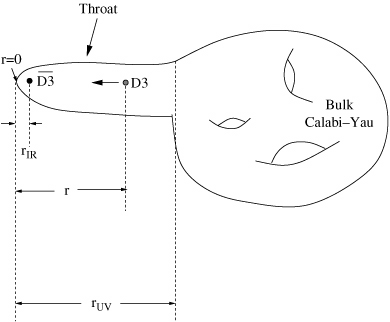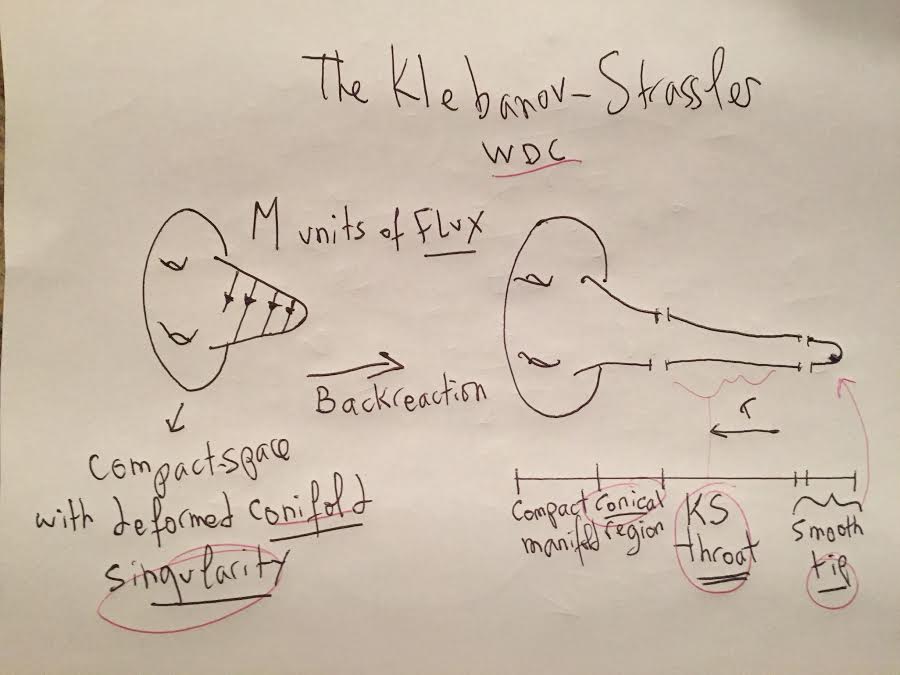I last showed that the AdS/CFT correspondence states that, for large N, classical supergravity on this background is dual to strongly coupled 4-d N = 4 SU(N) superYang-Mills theory and the conformality of the 4-d theory is reflected by translational invariance along the r direction of the 5-d AdS space and provides a stringy realization of the Randall-Sundrum-II model
This is deep, and in this post, I will delve into Klebanov-Strassler warped throat conifold analysis. Recal that the low-energy limit of type IIB superstring theory is type IIB supergravity, whose action is
![Rendered by QuickLaTeX.com \[\begin{array}{c}S = \frac{{M_{10}^8}}{2}\int {{d^{10}}} x\sqrt { - g} \left( {R - \frac{{{{\left| {{{\not \partial }_\tau }} \right|}^2}}}{{2{{\left( {{\rm{Im}}\tau } \right)}^2}}}} \right.\\ - \frac{{{{\left| {{G_3}} \right|}^2}}}{{12{\rm{Im}}\tau }} - \left. {\widetilde F_5^2} \right) + \\\frac{{M_{10}^8}}{{8i}}\int {\frac{{{C_4} \wedge {G_3} \wedge {{\bar G}_3}}}{{{\rm{Im}}\tau }}} + fermions\end{array}\]](https://www.georgeshiber.com/wp-content/ql-cache/quicklatex.com-172b749a0eb673d087f7b072a2f0b953_l3.png)
by which is meant ‘fermion-terms’, with ![]() the 10-d reduced Planck mass, and
the 10-d reduced Planck mass, and ![]() the 10-d Einstein frame metric with Ricci scalar
the 10-d Einstein frame metric with Ricci scalar ![]() , and
, and ![]() is the axio-dilaton, formed from the Ramond-Ramond axion
is the axio-dilaton, formed from the Ramond-Ramond axion ![]() , with the dilaton
, with the dilaton ![]() defined by
defined by
![]()
and that placing N coincident D3-branes in 10-d flat spacetime will deform the warped-throat internal-space metric, thus yielding
![]()
with
![Rendered by QuickLaTeX.com \[\left\{ {\begin{array}{*{20}{c}}{h(r) = 1\frac{{{R^4}}}{{{r^4}}}}\\{{R^4} = 4\pi {g_s}N{{\alpha '}^2}\frac{{{\pi ^3}}}{{{\rm{Vol}}\left( {{S^5}} \right)}} = 4\pi {g_s}N{{\alpha '}^2}}\end{array}} \right.\]](https://www.georgeshiber.com/wp-content/ql-cache/quicklatex.com-f185dd8867a24a8ce4095066310ecd89_l3.png)
visually…
and this space is asymptotically flat as ![]() , given that
, given that ![]() . For small
. For small ![]() , the second term dominates, and the metric becomes that of
, the second term dominates, and the metric becomes that of ![]()
![]()
with the branes sourcing N units of ![]() flux through the internal
flux through the internal ![]() . In this post, I will try and show via
. In this post, I will try and show via
Klebanov-Strassler warped conifold analysis, that the AdS/CFT dual of supergravity on the warped conifold background is a 4-D N = 1 superconformal gauge theory
First, note that a Klebanov-Strassler geometry naturally arises by considering string theory compactification on ![]() where
where ![]() is the Einstein manifold in five dimensions, with the interaction-Lagrangian of the massless Klebanov-Strassler field and the brane fields fermions is
is the Einstein manifold in five dimensions, with the interaction-Lagrangian of the massless Klebanov-Strassler field and the brane fields fermions is
![Rendered by QuickLaTeX.com \[\begin{array}{c}{{\not L}^{KS}}_{\psi \bar \psi {H^0}}\frac{1}{{{M^{3/2}}}}\bar \psi \left[ {i{\gamma ^\mu }} \right.{\sigma ^{\mu \nu }}H_{\mu \nu \lambda }^0\left( {{x^\mu }} \right)\\\left. {\frac{{{\chi ^0}(r)}}{{\sqrt {\tau c} }}} \right]\psi \end{array}\]](https://www.georgeshiber.com/wp-content/ql-cache/quicklatex.com-f34d5cb329967b82724e34e08774d421_l3.png)
and after integrating over the extra dimensional part, the effective 4-D Lagrangian reduces to
![Rendered by QuickLaTeX.com \[\begin{array}{c}\not L_{\psi \bar \psi {H^0}}^{KS} = i\bar \psi {\gamma ^\mu }{\sigma ^{\mu \nu }}\left[ {\frac{{{e^{ - 4\pi K/{3_{{g_s}}}M}}}}{{{M_{pl}}}}} \right. \cdot \\\left. {\left( {\frac{{{r_{\max }}}}{{{r_0}}}} \right)} \right]H_{\mu \nu \lambda }^0\psi \end{array}\]](https://www.georgeshiber.com/wp-content/ql-cache/quicklatex.com-4fb159e826a96c1b6771b5777befc02e_l3.png)
with the fundamental Planck scale ![]() and the 4-D Planck scale
and the 4-D Planck scale ![]() related as
related as
![Rendered by QuickLaTeX.com \[{M_{pl}} = \frac{{{M^{3/2}}}}{{\sqrt {2R} }}{r_{\max }}{\left( {1 - \frac{{r_0^2}}{{r_{\max }^2}}} \right)^{1/2}}\]](https://www.georgeshiber.com/wp-content/ql-cache/quicklatex.com-1d1ae592dee4246ec817f92c3979f106_l3.png)
Let us consider a IIB compactification on a Calabi-Yau 3-fold M which has a conical singularity. Placing N D3-branes at the singular point yields a deformation of the metric as in above, and is
![]()
with
![Rendered by QuickLaTeX.com \[\left\{ {\begin{array}{*{20}{c}}{h(r) = 1 + \frac{{{R^2}}}{{{r^4}}}}\\{{R^4} = 4\pi {g_s}N{{\alpha '}^2}\frac{{{\pi ^3}}}{{{\rm{Vol}}\left( {{X_5}} \right)}}}\end{array}} \right.\]](https://www.georgeshiber.com/wp-content/ql-cache/quicklatex.com-0f1263b6b7f48b6e53ec4452a7f6250e_l3.png)
And this is deep because:
spacetime at small  converges to the
converges to the  throat, whereas at large
throat, whereas at large  it is given by
it is given by 
and hence, in the throat, supergravity is dual to a conformal field theory in 4-D. The Klebanov-Strassler warped deformed conifold arises by considering
![]()
The conifold is the cone  over
over  : a non-compact singular Ricci-flat manifold
: a non-compact singular Ricci-flat manifold
The metric near N D3-branes at a conifold singularity is
![]()
and with
![Rendered by QuickLaTeX.com \[\left\{ {\begin{array}{*{20}{c}}{h(r) = 1 + \frac{{{R^4}}}{{{r^4}}}}\\{{R^4} = \frac{{27\pi }}{4}{g_s}N{{\alpha '}^2}}\end{array}} \right.\]](https://www.georgeshiber.com/wp-content/ql-cache/quicklatex.com-41c00416461dc98554192dddb06e5c7d_l3.png)
with solution N units of ![]() flux through the internal
flux through the internal ![]() , visually as
, visually as
and ![]() is topologically
is topologically ![]() ,
,
and at the conifold singularity both the 3-cycle and the 2-cycle shrink to zero size
The deformed conifold is a non-singular, non-compact manifold that admits a Calabi-Yau metric and when placing M units of ![]() flux on the 3-cycle, the flux backreaction on the geometry gives the warped deformed conifold. One can interpret this
flux on the 3-cycle, the flux backreaction on the geometry gives the warped deformed conifold. One can interpret this ![]() flux as sourced by D-branes and crucially, as noted visually, in the warped conifold throat context, D3-branes live at the singularity
flux as sourced by D-branes and crucially, as noted visually, in the warped conifold throat context, D3-branes live at the singularity
The throat metric, excluding the tip, is the Klebanov-Tseytlin one
![]()
with
![Rendered by QuickLaTeX.com \[\left\{ {\begin{array}{*{20}{c}}{\tilde h(r) = 1 + \frac{{R_{eff}^4(r)}}{{{r^4}}}}\\{R_{eff}^4(r) = \frac{{27}}{4}\pi {g_s}(r){{\alpha '}^2}}\\{{N_{eff}}(r) = \frac{3}{{2\pi }}{g_s}{M^2}\log \frac{r}{{{r_s}}}}\end{array}} \right.\]](https://www.georgeshiber.com/wp-content/ql-cache/quicklatex.com-f0e7879cb435ddec51f2693f558682bc_l3.png)
with ![]() is the singularity deformation parameter size, and the Klebanov-Tseytlin metric becomes singular for
is the singularity deformation parameter size, and the Klebanov-Tseytlin metric becomes singular for ![]() and no longer valid in the domain
and no longer valid in the domain ![]() , and the complete throat is perfectly smooth also at its tip, thus we have the following ‘picture’
, and the complete throat is perfectly smooth also at its tip, thus we have the following ‘picture’
And as one goes along the throat, there are ![]() units of
units of ![]() flux through
flux through ![]() at the radial coordinate r
at the radial coordinate r
![Rendered by QuickLaTeX.com \[\begin{array}{c}\left( {4{\pi ^2}\alpha '} \right){N_{eff}}(r) = \int\limits_{{T^{1,1}}\,{\rm{at}}\,r} {{{\tilde F}^5}} = \\\left( {\int\limits_{{S^3}\,{\rm{at}}\,r} {{F_3}} } \right)\left( {\int\limits_{{S^2}\,{\rm{at}}\,r} {{B_2}} } \right)\end{array}\]](https://www.georgeshiber.com/wp-content/ql-cache/quicklatex.com-c1ddaa5159d1519d6e7e6272567deed9_l3.png)
With the general ansatz
![]()
the logarithmic dependence
![Rendered by QuickLaTeX.com \[\left\{ {\begin{array}{*{20}{c}}{\tilde h(r) = 1 + \frac{{R_{eff}^4(r)}}{{{r^4}}}}\\{R_{eff}^4(r) = \frac{{27}}{4}\pi {g_s}(r){{\alpha '}^2}}\\{{N_{eff}}(r) = \frac{3}{{2\pi }}{g_s}{M^2}\log \frac{r}{{{r_s}}}}\end{array}} \right.\]](https://www.georgeshiber.com/wp-content/ql-cache/quicklatex.com-f0e7879cb435ddec51f2693f558682bc_l3.png)
of ![]() on
on ![]() can be be gotten as such: for a finite segment of the throat, between
can be be gotten as such: for a finite segment of the throat, between ![]() and
and ![]() , we have
, we have
![Rendered by QuickLaTeX.com \[\begin{array}{c}{\left( {4{\pi ^2}\alpha '} \right)^2}\left( {{N_{eff}}({r_2}) - {N_{eff}}({r_1})} \right) = \\\int\limits_{{T^{1,1}}\,{\rm{at}}\,{r_2}} {{{\tilde F}_5}} - \int\limits_{{T^{1,1}}\,{\rm{at}}\,{r_1}} {{{\tilde F}_5}} = \\\int\limits_{{T^{1,1}} \times \left[ {{r_1};{r_2}} \right]} {d{{\tilde F}_5}} = \int\limits_{{T^{1,1}} \times \left[ {{r_1};{r_2}} \right]} {{H_3} \wedge {F_3}} \end{array}\]](https://www.georgeshiber.com/wp-content/ql-cache/quicklatex.com-49007cc7ed1698bc2420a124a5a67c2b_l3.png)
Since ![]() is imaginary self-dual, one has
is imaginary self-dual, one has
![]()
and because ![]() has zero components in the
has zero components in the ![]() direction, one can derive
direction, one can derive
![]()
with the ![]() metric being
metric being
![]()
and inserting into
![Rendered by QuickLaTeX.com \[\begin{array}{c}{\left( {4{\pi ^2}\alpha '} \right)^2}\left( {{N_{eff}}({r_2}) - {N_{eff}}({r_1})} \right) = \\\int\limits_{{T^{1,1}}\,{\rm{at}}\,{r_2}} {{{\tilde F}_5}} - \int\limits_{{T^{1,1}}\,{\rm{at}}\,{r_1}} {{{\tilde F}_5}} = \\\int\limits_{{T^{1,1}} \times \left[ {{r_1};{r_2}} \right]} {d{{\tilde F}_5}} = \int\limits_{{T^{1,1}} \times \left[ {{r_1};{r_2}} \right]} {{H_3} \wedge {F_3}} \end{array}\]](https://www.georgeshiber.com/wp-content/ql-cache/quicklatex.com-49007cc7ed1698bc2420a124a5a67c2b_l3.png)
and differentiating, one gets
![Rendered by QuickLaTeX.com \[\begin{array}{c}\frac{{d{N_{eff}}(r)}}{{dr}} = \frac{{{g_s}}}{{{{\left( {4{\pi ^2}\alpha '} \right)}^2}}} \cdot \\\int\limits_{{T^{1,1}}} {{d^5}} \bar y\sqrt {\bar g} {F_{\bar m\bar n\bar p}}{F^{\bar m\bar n\bar p}}\end{array}\]](https://www.georgeshiber.com/wp-content/ql-cache/quicklatex.com-aa68eb90a697a5f66ba817c4bcab8c6f_l3.png)
and with the quantization condition
![]()
implying the scaling ![]() for the non-vanishing components of
for the non-vanishing components of ![]() , we get our desired result
, we get our desired result
![]()





